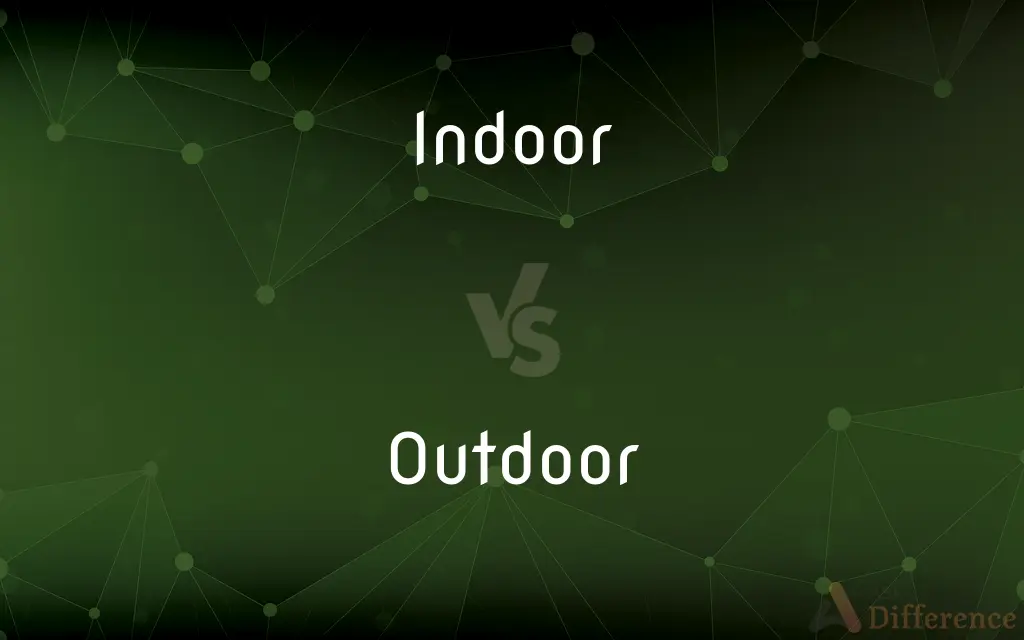Indoor vs. Outdoor — What's the Difference?
Edited by Tayyaba Rehman — By Maham Liaqat — Updated on April 17, 2024
Indoor environments are enclosed and controlled spaces, suitable for year-round activities regardless of weather; outdoor settings are open, influenced by natural elements, and offer a broader scope for physical activities.

Difference Between Indoor and Outdoor
Table of Contents
ADVERTISEMENT
Key Differences
Indoor environments, such as homes, offices, or gyms, provide shelter and control over factors like temperature and lighting, enhancing comfort and facilitating activities like work or exercise in any weather condition. On the other hand, outdoor environments expose individuals to natural elements, which can be invigorating or challenging, depending on the weather, and often require adaptability.
While indoor settings often utilize artificial lighting and ventilation, ensuring a consistent environment conducive to activities like meetings or detailed artistic projects, outdoor settings benefit from natural light and fresh air, which are linked to improved mood and health, but can vary dramatically with weather conditions.
Indoor areas typically require more deliberate planning and can incur higher costs due to the need for heating, cooling, and maintenance. Conversely, outdoor areas generally have lower direct costs but can be less predictable and sometimes less accessible during adverse weather conditions.
Indoor activities can be more private and secure, offering controlled access and a refuge from external disturbances. In contrast, outdoor activities are typically more public and provide a sense of freedom and connection to nature, though they can be less secure and private.
Indoor spaces often have size limitations and specific design constraints, which can restrict the types of activities performed. Outdoor spaces, however, usually offer more room and flexibility in terms of scale and type of activity, although they may lack the infrastructure and facilities available indoors.
ADVERTISEMENT
Comparison Chart
Environment Control
High (temperature, lighting)
Low (subject to weather)
Light Source
Artificial and controlled
Natural, varies with time and weather
Costs
Higher (maintenance, utilities)
Lower, but dependent on activity
Privacy and Security
More private and secure
Less private, open to public
Space and Flexibility
Often limited by walls and design
Generally more expansive and adaptable
Compare with Definitions
Indoor
Activities performed inside a structure.
Indoor gardening is popular among those with limited outdoor space.
Outdoor
Involving or relating to the open air.
Outdoor dining became popular as a safer dining option.
Indoor
Geared towards or suitable for the inside of a building.
Indoor paint differs from outdoor paint in its formulation.
Outdoor
Geared towards or suitable for outside conditions.
Outdoor gear is designed to withstand the elements.
Indoor
Relating to a contained environment within buildings.
Indoor air quality is an important health consideration.
Outdoor
Pertaining to or located outside a building
Outdoor activities like hiking boost physical health.
Indoor
Pertaining to or situated within a building.
Indoor sports avoid weather disruptions.
Outdoor
Areas that are not enclosed by walls.
Outdoor markets attract a diverse crowd.
Indoor
Areas enclosed by walls and a roof.
Indoor venues are preferred for conferences.
Outdoor
Activities performed in natural settings.
Outdoor photography often requires good natural lighting.
Indoor
Of, situated in, or intended for use in the interior of a building
An indoor pool.
Indoor paint.
Outdoor
Done, situated, or used out of doors
A huge outdoor concert
Indoor
Carried on within doors
An indoor party.
Indoor gardening.
Outdoor
Located in, done in, or suited to the open air
Badminton and other outdoor games.
Indoor
Situated in, or designed to be used in, or carried on within, the interior of a building.
These fireworks are not for indoor use!
Outdoor
Situated in, designed to be used in, or carried on in the open air.
Indoor
Done or being within doors; within a house or institution; domestic; as, indoor work.
Outdoor
Pertaining to charity administered or received away from, or independently from, a workhouse or other institution.
Indoor
Located, suited for, or taking place within a building;
Indoor activities for a rainy day
An indoor pool
Outdoor
(in some African communities) To publicly display a child after it has been named
Indoor
Within doors;
An indoor setting
Outdoor
Being, or done, in the open air; being or done outside of certain buildings, as poorhouses, hospitals, etc.; as, outdoor exercise; outdoor relief; outdoor patients.
Outdoor
Located, suited for, or taking place in the open air;
Outdoor clothes
Badminton and other outdoor games
A beautiful outdoor setting for the wedding
Outdoor
Pertaining to or concerning the outdoors or outdoor activities;
Outdoor education is the area of teacher training concerned with training for outdoor activities
Common Curiosities
Can indoor spaces offer the same level of interaction with nature as outdoor spaces?
No, indoor spaces cannot provide the same level of interaction with nature as outdoor spaces, which offer direct exposure to natural environments.
What are the main benefits of indoor environments?
Indoor environments offer controlled conditions that are unaffected by outdoor weather, providing comfort and consistency for various activities.
What makes outdoor activities less predictable than indoor ones?
Outdoor activities are subject to changes in weather and environmental conditions, making them less predictable than indoor activities.
How do outdoor environments impact health?
Exposure to natural light and air in outdoor environments has been shown to improve mood and physical health.
Are indoor activities more costly than outdoor activities?
Generally, indoor activities can be more costly due to the need for building maintenance and utilities, whereas outdoor activities often have lower or no such costs.
What are the advantages of natural lighting in outdoor settings?
Natural lighting in outdoor settings not only enhances visual clarity but also benefits mental health and wellbeing.
How do privacy concerns differ between indoor and outdoor settings?
Privacy concerns are greater in outdoor settings due to their open nature and public accessibility, unlike more secluded indoor settings.
What are the challenges of artificial lighting in indoor settings?
Artificial lighting in indoor settings can lead to energy consumption concerns and sometimes does not replicate the benefits of natural sunlight.
What type of activities are better suited for indoor environments?
Activities that require controlled environments, such as scientific research, art projects, or indoor sports, are better suited for indoor environments.
How do indoor and outdoor settings affect event planning?
Event planning in indoor settings requires consideration of space limitations and amenities, while outdoor events must account for weather and environmental factors.
How do the costs of maintaining indoor and outdoor spaces compare?
Maintaining indoor spaces typically involves ongoing costs for utilities and infrastructure, whereas outdoor spaces often require less regular maintenance.
Why are indoor settings considered more secure?
Indoor settings are more secure due to controlled access and protection from external influences, unlike open and publicly accessible outdoor settings.
What are the limitations of outdoor activities regarding weather?
Outdoor activities can be limited by adverse weather conditions like rain, snow, or extreme temperatures, which can hinder accessibility and enjoyment.
Are there activities that can only be performed in outdoor settings?
Certain activities, such as mountain biking or large-scale festivals, are typically only feasible in outdoor settings due to space and environmental needs.
Is there a difference in the flexibility of use between indoor and outdoor spaces?
Yes, outdoor spaces often offer greater flexibility in terms of scale and types of activities, while indoor spaces are usually constrained by physical boundaries and infrastructure.
Share Your Discovery

Previous Comparison
Feu vs. Fey
Next Comparison
Imprisonment vs. IncarcerationAuthor Spotlight
Written by
Maham LiaqatEdited by
Tayyaba RehmanTayyaba Rehman is a distinguished writer, currently serving as a primary contributor to askdifference.com. As a researcher in semantics and etymology, Tayyaba's passion for the complexity of languages and their distinctions has found a perfect home on the platform. Tayyaba delves into the intricacies of language, distinguishing between commonly confused words and phrases, thereby providing clarity for readers worldwide.















































